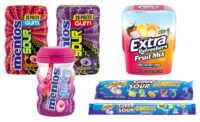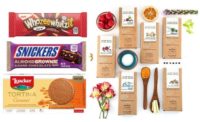
Although marshmallows may not hold as coveted a title as chocolate does -Theobroma, the food of the gods - they still do have a royal heritage, one that goes back to 2000 B.C. Using the root of the mallow plant, typically found in marshes, Egyptian priests prepared a mix of mallow and honey to create super-sweet delicacies reserved only for the pharaohs.
Today, the ubiquitous marshmallow winds up most often in the kitchen pantry, ready to be incorporated into gelatin moulds, hot cocoa, fruit salads or candied yams. Thanks to those clever Girl Scouts, roasted marshmallows (sandwiched between graham crackers and chocolate) also have become a hallowed campfire tradition in the form of s’mores.
Of course, marshmallows also are simply consumed as a sweet treat, a fact that Elk Grove Village, Ill-based Doumak, Inc. believes offers enormous potential for growing the category, says Mark Schuessler, the company’s vice president of sales and marketing.
Core consumers of the category, estimated at $180 million in the United States, are parents with young children, he notes. That number includes parents whose ages range from 20 to 50, Schuessler adds.
During a series of consumer focus groups held last December, Schuessler, along with director of sales Donald Muff, discovered some interesting truisms while soliciting opinions on the company’s newest product rollout:fruitswirlers.

Plant manager Terry King keeps a close eye on marshmallows heading toward the first of three tumblers involved in finishing the product prior to packaging.
Consumers expressed interest in seeing some innovation in the category, beginning with packaging and continuing through product size.
“For moms, the regular size was too large and the minis proved to be a pain, spilling out everywhere,” he says.
As it turned out,fruitswirlers addressed several of those needs. Developed over a period of eight months, the product had - like many innovations - familiar origins.
“During production of flavored marshmallows, we’d notice that occasionally an injector would go out, causing the color to streak in the marshmallow,” explains Barry Blum, president of Doumak. “We thought it made for an interesting looking marshmallow and wanted to see if we could replicate this on a consistent basis.”
Blum, who actually got his start at Doumak by equipping its laboratory for former owners Bob and Alex Doumakes, has been involved in producing marshmallows for nearly 40 years.
With Blum’s encouragement, Gary Conway, v.p. of operations, began experimenting with ways to produce the color streaks consistently, yet creatively.
“When the color pumps plugged up, that’s when we would get the streaks,” Conway says. “We had to go through five designs of pumps before we got the desired effect.”
Not only were the streaks visually appealing, they also matched new flavor profiles; the traditional vanilla flavor was mixed with strawberry, lime, orange and lemon flavors. In addition, the marshmallows were reduced to a bite-sized portion.
When Schuessler and Muff asked consumers what they thought of the new size, the response was immediate: “What took you so long?”

Operator Jose Nunez demonstrates the cooking process for marshmallows, which begins with batch mixing of ingredients and then involves aeration and rapid heating and cooling before the mass is pumped into an extrusion manifold.
It didn’t take the two sales executives long to recognize the importance of that and other insights, sparking several tweaks to the packaging.
This September, Doumak launched itsfruitswirlers in a clear 8-oz. bag, highlighted by bold colors and several key color blurbs. First, the packaging proclaims that marshmallows are “naturally fat free!” as well as “gluten-free.” In addition, a large red button proclaims that the marshmallows are “great for snacking.”
Beginning in January 2010, the company will come out with a resealable standup pouch.
“We believe this will be a breakthrough product for the category,” Schuessler says. “With the new look, size and taste, it will make consumers think differently about the category.”
But as is typical with most breakthroughs, the evolution had its beginnings several years earlier.
Although Doumak had three brands of its own prior to the acquisition ofCampfire in 2003 -Fireside,Snow WhiteandWonder Food - none of those had the national distribution and stature ofCampfire.
As the oldest marshmallow brand in the United States, dating back to 1917,Campfire underwent several ownership changes. When Doumak purchased the brand from Conagra, it already was very familiar with the product, since the company manufactured it under contract for Borden in the 1980s.
In acquiringCampfire, Blum believed the brand needed contemporizing. Nevertheless, before making any changes, Doumak’s chief executive thought it would be wise to engage consumer focus groups, a move that delivered much “more than we expected,” he says. For openers, consumer feedback prevented the company from making a major mistake.
“We, of course, had been thinking of changing the packaging and thought it would be interesting to go to a polypropylene bag, which would make the package stiffer,” Blum says.
“It’s a good thing we asked the focus group, because consumers told us that we shouldn’t dare change the packaging material since they enjoy squeezing, feeling and smelling the product.”

Operator Mario Vargas checks on the diameter of the marshmallow ropes as they come off the extrusion manifold. The ropes are layered with starch from above and below as they move toward the cutting tool. Terry King, plant manager, and Gary Conway, v.p. – manufacturing, monitor progress as the marshmallow pieces receive another coating of starch.
As Schuessler relates, the category had only five SKUs (stock keeping units) for years and years. Even retailers expressed interest in seeing more variety.
In 2005, after digesting the recommendations, the company introduced packaging featuring a newCampfire logo, a redesigned mascot (“Campy” no longer featured flames licking his feet - a sore point with moms) and a color-coded theme for varieties (a burnt orange color for regular-sized marshmallows, blue for minis and purple for colored marshmallows).
The changes continued as Doumak began to think beyond the baking ingredient aisle. In addition to product development, Blum, Schuessler and Muff worked on addressing usage and channel challenges.
The launch of 1-oz. minis, available in a 24-count tray, opened the door for selling the product both in convenience stores and warehouse stores. The 8-count, 5-oz.tray proved ideal for a broad range of specialty retailers, ranging from camp stores to gas marts.
The revitalization process didn’t go unnoticed.
One day, Doumak was approached by customers seeking a manufacturer that could produce a marshmallow that would appeal to Hispanic tastes.
“Seems their original supplier wasn’t capable of delivering a consistent product regarding flavor,” explains Blum.
In meeting the challenge of formulating a Tutti Frutti flavor for its client, Doumak also introduced aCampfire sub-brand dubbedSabrosos for the Hispanic market. The white and pink marshmallows not only attracted ethnic shoppers, but proved to have cross-over draw, as well.
“Our original thinking was to capture a niche,” Schuessler says. “But it turned out that Sabrosos appeals to the mainstream consumer as well. Retailers were coming to us inquiring about the product.”
In general, flavored marshmallows have gained popularity, the vice president of sales and marketing points out. “A few years ago, they represented anywhere from 3% to 4% of sales,” he says. “Today, they account for more than 10%.”
And there are more innovations on the way, Blum asserts.

At the company’s Elk Grove Village facility, plant manager Damon Fugate checks the integrity of a 10.5-oz bag of Campfire marshmallows headed toward a robotic case packaging station. A case erector sends cartons toward the robotic arm, which packs the bags into the carton prior to sealing and palletizing.
Although, Blum is a bit reluctant to divulge what’s coming down the innovation pipeline, he’s optimistic about future launches. As mentioned before, many of the rollouts stem from past successes, such as formulating a kosher marshmallow recipe using fish gelatin in a manner that doesn’t result in marshmallows sticking together. Today, Doumak also offers a halal marshmallow.
When pressed about upcoming rollouts, Blum mentioned that there would be additional extensions to theCampfire line involving new flavors, colors and gelatins. The company also looks to expand its export sales. Currently, the company sells its marshmallows to more than 40 countries.
“During the past several years, we’ve seen exports grow at a 15% annual rate,” Schuessler says.Candy Industryestimates annual sales at just under $85 million.
It’s a steady business that, like many confectionery companies, enjoys a fourth-quarter spike because of the holidays. And despite having to deal with the Great Recession, the company’s marshmallow sales didn’t suffer a significant downturn.
One of the reasons for such resiliency is the company’s ability to produce high-quality marshmallows efficiently. With two facilities (70,000 sq. ft. in Bensenville, Ill., and 52,000 sq. ft. in Elk Grove Village, Ill.) located a mere four miles apart, there’s plenty of flexibility and capacity.
And given that Alex Doumakes invented the extrusion process for making marshmallows back in 1948, doubling output and reducing labor as result, it’s safe to say that there’s a high level of processing competency at the company.
Blum actually worked for a year with the marshmallow extrusion inventor, during which he taught Blum “all he knew about the process.”
Since those days, the marshmallow production process has undergone several refinements and improvements, specifically with temperature control. As Blum explains, temperature and humidity are critical to the process.
A typical production run begins by mixing corn syrup, sugar, dextrose and water into a batch. After cooking, the batch is pumped into a cooling tank, after which a gelatin slurry is introduced.

Members of Doumak’s management team: (From l. to r.) Mark Schuessler, v.p. – sales and marketing; Barry Blum, president; Don Muff, director of sales; and Gary Conway, v.p. – operations.
The aerating quickly raises the temperature, which has to be lowered before it can be extruded. A scraped surface heat exchanger drops the temperature down before moving the mass to an extrusion manifold, a series of pipes.
Prior to extruding the marshmallow mass onto a forming table, corn starch is deposited onto the conveyor belt. As the marshmallow rolls gently slide onto the belt, corn starch is automatically deposited onto top of the “ropes.” The ropes then move toward a cutter, which slices the ropes into a variety of sizes.
At that point, the pieces head toward the first tumbler, which ensures separation of the pieces. The individual pieces then move toward a second tumbler, which douses the marshmallows with corn starch again to form a “skin.”
A third tumbler finishes the process by removing excess corn starch, feeding the individual marshmallow pieces to a series of form/fill/seal packaging machines. A robotic system at the Elk Grove Village facility speeds packaging of bags into cartons.
During the entire production process, quality assurance personnel perform hourly tests involving starch level, weight and percent solids checks. Metal detector checks also are part of the routine. All batches are tracked via lot numbers to ensure traceability.
“You have to remember that marshmallows are delicate products, and there are all sorts of environmental factors once they leave the plant that can have an impact,” says Conway.
Thanks to its expertise and process controls, Doumak prides itself on producing the best quality marshmallows in the marketplace, Blum adds. Part of that stems from its ability to quickly move the marshmallow mass through cooling and then extrusion. It also comes from keeping meticulous records on temperature and humidity as well as monitoring weather conditions as they arise.
But then, such attention to detail reflects the company’s heritage. After all, when you’re producing treats for the pharaohs, they have to be perfect.

At a Glance
Doumak, Inc.Headquarters: Elk Grove Village, Ill.
Sales: $85 million (Candy Industryestimate)
Employees:170
Plants: 2 (Bensenville and Elk Grove Village, Ill.)
Products: Marshmallows, dehydrated marshmallows
Brands: Campfire,Fireside,Rocky Mountain
Sales Breakout: Private label - 75%; branded - 25%
Management Team: Barry Blum, president; John Casey, executive v.p. of finance; Gary Conway, v.p. of operations; Mark Schuessler, v.p. of sales and marketing; Don Muff, director of sales





